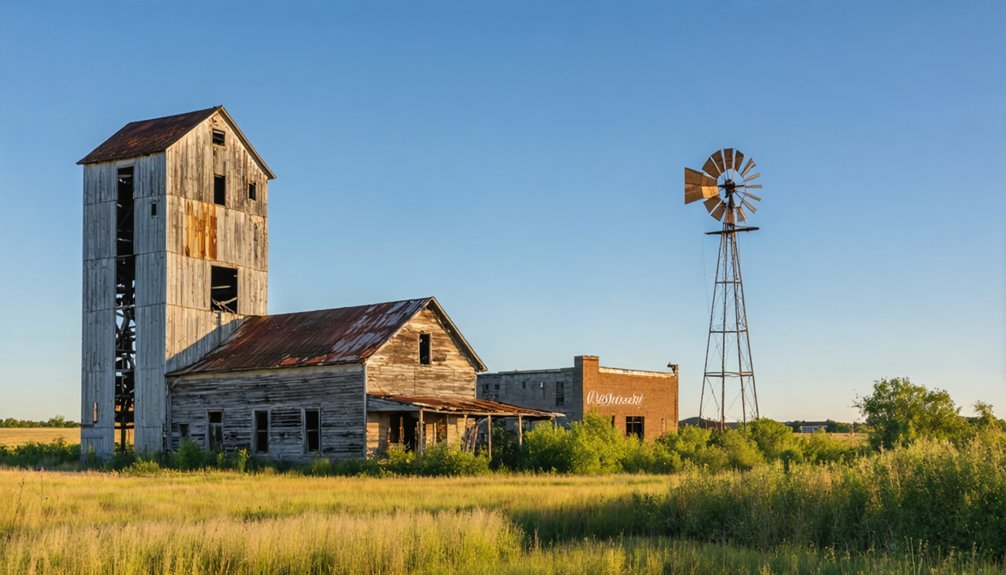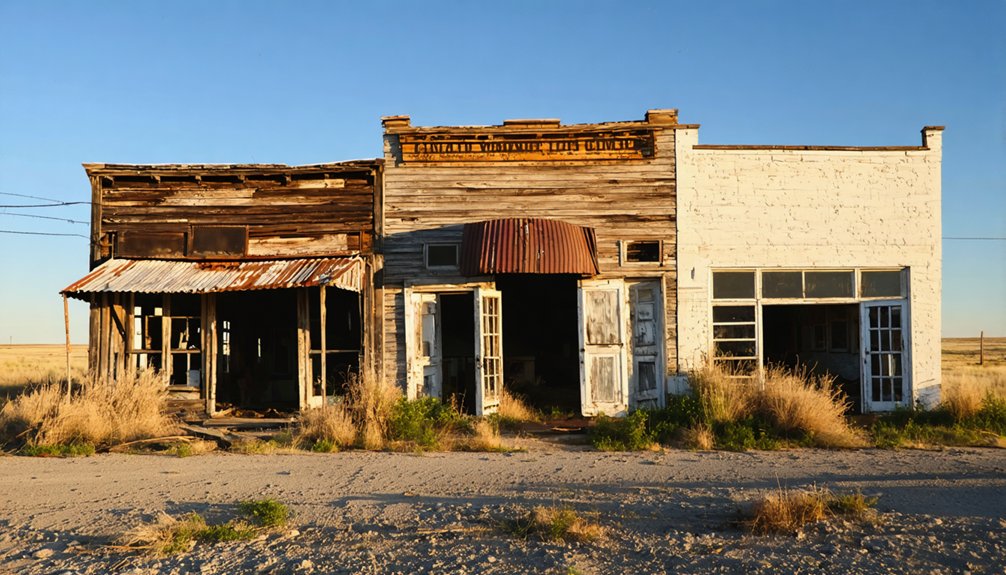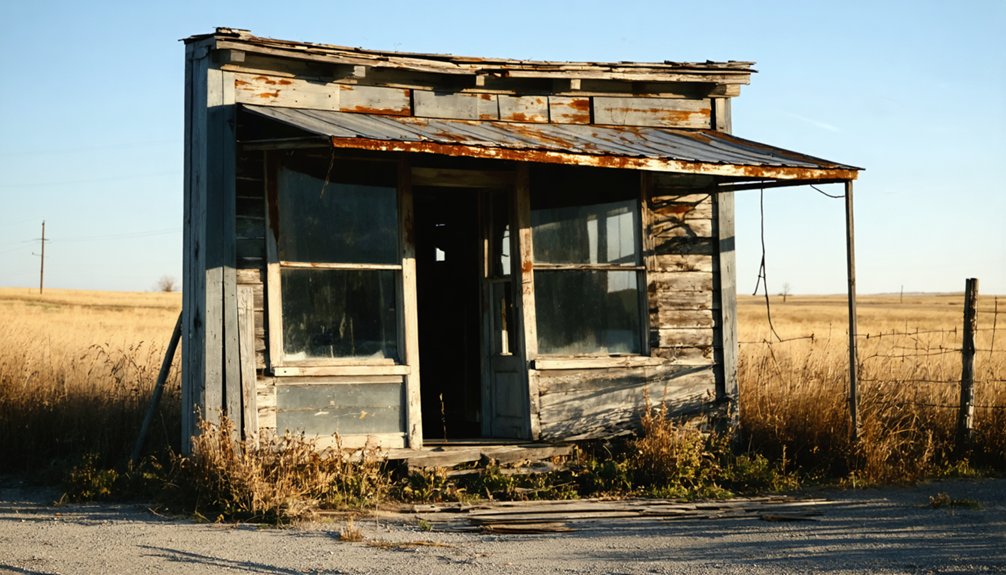You’ll find New Chicago‘s remains near Deadwood, South Dakota, where it emerged as a thriving mining camp in the mid-1870s after rich galena deposits were discovered. The settlement grew rapidly around operations like the McDonald Smelter and Hidden Treasure Mine before merging with Garden City in 1877. Despite $10 million in mining capitalization, environmental challenges and dwindling ore led to its abandonment by 1915. The ghost town‘s weathered foundations still whisper tales of Black Hills frontier life.
Key Takeaways
- New Chicago began as a mining camp near Deadwood in the 1870s after rich galena deposits were discovered in the Black Hills.
- The town merged with Garden City in 1877 to streamline mining operations and establish clearer property boundaries.
- Mining activities centered around the McDonald Smelter and Hidden Treasure Mine, with both placer and lode mining methods used.
- Environmental challenges, including floods, toxic soil contamination, and harsh weather, contributed to the settlement’s eventual decline.
- By 1915, New Chicago had become a ghost town due to depleted ore deposits and dwindling mining fortunes.
The Birth of a Mining Camp
When prospectors discovered rich galena deposits in the Black Hills during the mid-1870s, New Chicago sprang to life as a mining camp near Deadwood, South Dakota.
You’ll find its origins rooted in the region’s hard rock mining techniques, where determined prospectors sought their fortunes in gold, silver, and lead ores.
Settlement expansion happened quickly as miners staked their claims and built rudimentary wooden structures.
Miners rushed to establish their presence in New Chicago, hastily constructing basic shelters while marking their territory in the bustling settlement.
James Conzette’s 1876 cabin, initially planned as a defensive fort, stands as a symbol of the frontier spirit, though the camp never faced Native American conflicts.
The camp’s population swelled as mining operations grew more sophisticated, with assay offices and boarding houses popping up to support the influx of fortune seekers.
Like other ghost town remnants, only traces of foundations remain to mark where this once-bustling community stood.
Water rights became essential as both living quarters and ore processing operations demanded reliable sources.
McDonald Smelter, established in 1877, became a crucial operation as the first smelting facility in the Black Hills region.
Life in the Black Hills Gold Rush Era
The raw, untamed spirit of New Chicago mirrored the broader social dynamics sweeping through Black Hills mining settlements in the 1870s.
Like its neighbors, you’d find yourself in a community where fortunes rose and fell with each passing day. The transient lifestyle meant you might sleep in a canvas tent or crude wooden shack, while spending your evenings in rowdy saloons where cards, whiskey, and entertainment helped ease the harsh realities of frontier life.
If you weren’t striking it rich in the gold rush, you could’ve made a living as a merchant, blacksmith, or saloon keeper. Women ran boarding houses and laundries, while miners’ committees handled disputes before formal law arrived. The discovery of gold during Custer’s 1874 expedition had drawn thousands of hopeful prospectors to the region. The settlement violated the Treaty of Fort Laramie as miners flooded into Sioux territory.
Disease, fires, and mining accidents were constant threats, but the promise of wealth kept the community pushing forward despite the challenges.
Mining Operations and Economic Activities
Mining operations in New Chicago gained significant momentum after the Black Hills Gold Mining Company established itself in 1876, marking the first organized mining venture in the northern Black Hills region.
You’d find innovative mining techniques at sites like the Hidden Treasure Mine, where miners extracted gold from fossilized placers ranging from 2 to 12 feet thick. Early processing relied on Blake Crushers and Bolthoff Ball Pulverizers, later upgraded to more efficient 20-stamp mills.
The economic impact was substantial, with companies like Horseshoe boasting $10 million in capitalization. While profitable enough to pay dividends, you’d face significant challenges – from legal battles between rival mines to dangerous working conditions underground. By 1877, the area supported five local newspapers that chronicled the mining activities and development of the region.
The area saw a dramatic shift when lode mining operations became the dominant form of extraction by 1880, replacing the earlier placer mining methods.
Daily Life and Community Development
In New Chicago’s brief existence, you’d find a transient social structure typical of Black Hills mining camps, where miners and their families formed loose-knit support networks for survival.
Like many communities of the era, residents gathered at dance halls for much-needed social connection and celebration.
You’d have witnessed daily life centered entirely around mining work, with settlers sharing resources and helping each other through the harsh frontier conditions.
Living in simple cabins and tents, these pioneers faced the constant challenges of limited infrastructure, scarce supplies, and the isolation of their remote mountain settlement. Just like residents of Ardmore and Okaton, the community relied heavily on each other for both survival and social bonds.
Mining Camp Social Structure
Life in New Chicago revolved around a rigid social hierarchy that mirrored the mining industry‘s operational structure. At the top, you’d find mine owners, engineers, and speculators who controlled the town’s economic fate.
The middle tier consisted of skilled workers – assayers, chlorination specialists, and experienced miners who kept operations running. Laborers and support staff formed the foundation of this social pyramid.
You could see these divisions play out in daily life, where your position in the mines determined your social standing. The community adapted to challenging conditions as the Mystic Reduction Mill introduced new industrial processes in 1900. While the dangerous nature of mining work created bonds of camaraderie across ranks, the community’s social dynamics remained firmly tied to your role in the extraction process.
The shared boarding houses and saloons served as melting pots where these distinct social layers occasionally blurred. Much like a place name disambiguation, residents would often clarify their specific role and status when meeting others in these communal spaces.
Frontier Living Challenges
Through brutal winters and scorching summers, New Chicago’s hardy residents faced relentless challenges that tested their resilience daily. You’d have found yourself hauling water from streams, stockpiling supplies before snowstorms, and constantly watching for predatory wildlife that threatened your livestock.
Survival strategies centered on community cooperation, as you’d share resources and labor with neighbors to overcome the settlement’s isolation. Without formal stores or medical facilities, you’d rely on resource management skills – preserving food, maintaining primitive shelters, and treating illnesses with home remedies.
The nearest doctor might be days away by stagecoach on rough mountain roads. Your success depended on adapting to the harsh Black Hills terrain while dealing with unstable mining wages and unreliable supply deliveries.
The Merger With Garden City

You’ll find that New Chicago’s merger with Garden City in 1877 came as mining companies sought to streamline their operations in the Black Hills Gold Rush.
The consolidation led to a redrawing of property boundaries, allowing for more efficient management of the area’s complex ore processing needs, including chlorination plants and milling facilities.
Mining claims that once divided the two communities were unified under Garden City’s administration, creating a more cohesive approach to extracting gold and other precious metals from the region’s challenging ore deposits.
Mining Companies Unite
As the Black Hills gold rush gained momentum, New Chicago and Garden City’s property owners made a pivotal decision in February 1877 to unite their mining settlements under the Garden City name.
This merger brought significant benefits through shared resources and innovation in mining operations.
The unified Garden City Mining Company‘s key advantages included:
- Control of multiple mines including Beltram, Gold Eagle, and Echo
- Advanced ore processing through kilns and chlorination works
- Improved gold recovery from complex ores containing copper and silver
- Reduced operational costs through shared equipment
- Enhanced market position against larger competitors like Homestake
You’ll find this consolidation transformed these once-separate wildcat mining camps into an industrialized operation, setting new standards for corporate mining in Lawrence County while maintaining the region’s independent spirit during the late 1800s.
Property Boundaries Redrawn
When New Chicago and Garden City merged in February 1877, the process demanded a complete redrawing of property boundaries to unite the two mining settlements. The consolidation resolved ongoing property disputes between claim holders and established clear jurisdiction over mining operations, residential plots, and industrial sites.
You’ll find that these boundary negotiations were vital in transforming the fragmented mining camps into a cohesive town. The revised property lines enabled Garden City’s authorities to develop shared infrastructure, including roads and milling facilities.
The new boundaries also strengthened legal control over the area, making it easier to protect against unauthorized mining and squatters. By centralizing land ownership and updating property deeds, the merger created a more organized system that benefited both miners and residents throughout the expanded Garden City territory.
Environmental Challenges and Natural Disasters
The unforgiving climate and natural disasters of South Dakota’s Black Hills region have persistently challenged the survival of local ghost towns. As you explore New Chicago’s remains, you’ll witness the environmental degradation from severe weather events and natural disasters that have accelerated its decay over time.
The site’s vulnerability is evident through:
- Intense windstorms that have partially collapsed remaining structures
- Flash flood damage that’s eroded foundations and altered the landscape
- Thunderstorm-produced hail that’s battered wooden buildings
- Mining-related contamination that’s left toxic soil conditions
- Rapid weather changes unique to the Black Hills microclimate
You’ll find these harsh conditions, combined with the lack of maintenance after abandonment, have transformed New Chicago from a neglected settlement into today’s weathered ghost town.
The Final Days of a Frontier Settlement

Mining fortunes in New Chicago began their irreversible decline during the late 1880s, marking the beginning of the settlement’s final chapter.
You’ll find the settlement dynamics shifted dramatically as accessible ore deposits dwindled, causing miners and support workers to seek opportunities elsewhere. The once-bustling frontier community couldn’t sustain itself as the mining decline intensified.
While the Garden City Mining Company tried to maintain operations, you’d have seen the writing on the wall – diminishing returns couldn’t support the workforce.
The settlement’s fate was sealed as the transient population dispersed, leaving behind their temporary homes and dreams of striking it rich. By 1915, what remained of New Chicago, now part of Maitland, had largely emptied out, becoming another silent reflection of the boom-and-bust cycle of frontier mining towns.
Modern Legacy and Historical Significance
Today, you’ll find three distinct legacies of New Chicago woven into South Dakota’s historical fabric: its role in Black Hills mining development, its industrial innovations, and its cultural imprint on regional identity.
While the physical town has vanished, its cultural memory endures through historical research and ghost town tourism impact.
The town’s technological advances in ore processing highlight the evolution of mining practices:
- Advanced chlorination plants
- Roasting kilns for complex ore treatment
- Cyanide processing facilities
- Multiple productive mine operations
- Sophisticated metallurgical techniques
You’ll discover New Chicago’s story primarily through historical accounts rather than restored structures.
Unlike some commercialized ghost towns, this settlement’s legacy lives on through scholars and enthusiasts who study the Black Hills’ mining heritage, offering glimpses into the region’s boom-and-bust cycles and settlement patterns.
Frequently Asked Questions
Were There Any Documented Murders or Criminal Activities in New Chicago?
Like a book with blank pages, you won’t find documented murder investigations or criminal history in New Chicago’s records. All evidence suggests the town’s story was about mining, not mayhem.
What Was the Average Price of Land During New Chicago’s Peak?
You’d have found land values varying widely, from $50-$200 per town lot during peak economic growth, with higher prices near mines and railroads, though exact New Chicago records aren’t preserved.
Did Any Famous Personalities or Notable Figures Visit New Chicago?
Unlike today’s Instagram hotspots, you won’t find any celebrity sightings in New Chicago’s records. Historical visitors to this mining camp weren’t documented, though famous figures frequented nearby Deadwood instead.
What Happened to the Mining Equipment After the Town Was Abandoned?
You’ll find that most mining equipment was dismantled and relocated, while some pieces were salvaged for scrap. What wasn’t moved deteriorated underground or got destroyed by flooding and collapse.
Were There Any Native American Interactions With New Chicago Settlers?
You won’t find documented evidence of Native American interactions at this site. While settler conflicts and treaties shaped South Dakota’s history, no specific records connect indigenous peoples with New Chicago’s brief existence.
References
- https://www.legendsofamerica.com/sd-okaton/
- https://www.sdpb.org/rural-life-and-history/2023-08-21/some-black-hills-ghost-towns-and-their-origins
- https://www.powderhouselodge.com/black-hills-attractions/fun-attractions/ghost-towns-of-western-south-dakota/
- https://www.youtube.com/watch?v=Glucs_Rq8Xs
- https://www.sdhspress.com/journal/south-dakota-history-2-2/some-black-hills-ghost-towns-and-their-origins/vol-02-no-2-some-black-hills-ghost-towns-and-their-origins.pdf
- https://en.wikipedia.org/wiki/Maitland
- https://en.wikipedia.org/wiki/List_of_ghost_towns_in_South_Dakota
- https://b1027.com/south-dakota-has-an-abundance-of-ghost-towns/
- https://www.atlasobscura.com/things-to-do/south-dakota/ghost-towns
- https://www.legendsofamerica.com/galena-south-dakota/



